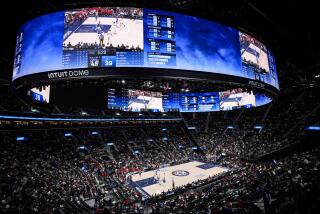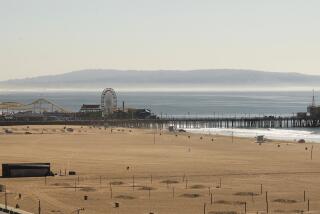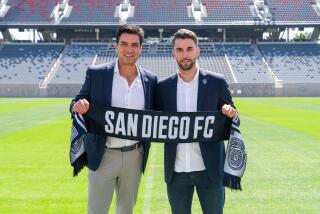Despite Odds, San Diego Pursues New Sports Arena : Attractions: The city has no tenant, and no sure way of funding construction. But mayor makes plan her top priority.
- Share via
SAN DIEGO — City officials here have spoken glowingly of building a $155-million, state-of-the-art downtown sports arena. Despite the absence of a full-time tenant and amid a flurry of fiscal concerns, Mayor Susan Golding labeled the project her top priority.
The City Council voted unanimously recently to give a group of private developers the right to come up with a plan to finance construction of the 20,000-seat sports palace near the city’s Convention Center and its blighted eastern waterfront, and city officials are working hard to lure a professional team.
But in light of its hefty price tag and the city’s checkered history with pro sports, some see the idea as a long shot at best. San Diego is a two-time loser with the National Basketball Assn., having lost the Rockets to Houston and the Clippers to Los Angeles. And its major league baseball franchise, the Padres, has hinted at moving.
The city has never had an entry in the National Hockey League, although its minor league team, the Gulls, draws more than some NHL franchises. The Gulls play in the Sports Arena, a 13,000-seat structure built in 1966, not far from the city’s airport.
Those in favor of a new arena say it could serve as an integral part of San Diego’s economic renaissance by attracting an NBA team--which could generate as much as $150 million a year for the city--as well as large conventions and concerts.
But the arena could also mean increased costs for San Diegans and visitors here. City officials are vague about how to pay for it, but Ron Hahn, the developer in charge of the undertaking, said an increase in hotel taxes is a possible source.
In a region still reeling from recession, $155 million is a lot of money. But Golding, who sees the arena as the catalyst to 1990s redevelopment, said that the city could conceivably bear the cost through bond sales--in effect, a loan against the future.
She cites the example of Baltimore, where $290 million in public funds was spent to build Oriole Park at Camden Yards, which triggered an avalanche of profitable redevelopment.
California’s ongoing recession has hit San Diego especially hard, forcing the demise of such home-grown institutions as HomeFed Bank and Great American Bank. Its Convention Center, which opened in 1989, has been successful, but it is too small to attract big-league conventions such as the 1992 Republican national convention that the city lost to Houston.
San Diego is also feeling heat from other cities. The Pond of Anaheim, which opened in June as home to the Mighty Ducks of the NHL, is bidding furiously to lure a franchise from the NBA.
Should an NBA team move to Anaheim, it would complicate--if not kill--San Diego’s chances and thus endanger the plan to build the arena, which city officials covet as a spur to development.
Golding and others say San Diego will not build the facility if it cannot attract a franchise from either the NBA or NHL. The mayor has met with several NBA owners and optimistically predicts that a basketball franchise will soon be moving to San Diego.
Sources close to the NBA said last week that the team most likely to move is the Indiana Pacers.
Marv Wolfenson, co-owner of the Minnesota Timberwolves of the NBA, also has expressed interest in moving. He visited San Diego on Wednesday, met with Golding and City Manager Jack McGrory and toured the city’s 27-year-old Sports Arena, which could be his temporary home while the new arena is being built.
Wolfenson is trying to extricate himself from a $74-million debt on the Minneapolis arena, where his team averages crowds of almost 18,000 a night. By comparison, the Clippers drew an average of only 7,927 fans a game during 1979-80, their best season in San Diego.
Bill Walton, the former UCLA All-American who starred on three professional teams--including the Clippers--and makes San Diego his home, believes the city is finally ready for the NBA.
“San Diego has matured as a city, plus the NBA is a better product today than in the previous eras when it was here. As long as the team is built around somebody who doesn’t have stress fractures of their feet, they’ll be just fine,” said Walton, whose basketball career was ended by foot injuries.
Gordon Clanton, a sociologist at San Diego State and an avid fan of the NBA, remembers Clipper home games that drew fewer than 3,000 people. As much as the former season ticket-holder wants pro basketball to return, he worries about the cost to the city.
“Does it make sense to invest tons and tons of cash when government has trouble keeping libraries open and can’t keep the grass mowed around the lakes?” he said. “This is an extraordinary expenditure. In the end, will it really pencil out?”
And community activist Jim Bliesner said the impact of a new arena on surrounding neighborhoods would be “potentially devastating . . . like dropping a boulder in the middle of a pond.”
City officials are talking of claiming a 12-block area dominated by warehouses, blue-collar businesses and shelters for the homeless, and displacing an undetermined number of residents from surrounding low-income neighborhoods.
The arena itself would consume a four-block area several miles south of the San Diego Zoo, within walking distance of the city’s mass transit line, the San Diego Trolley.
But how the city would foot the bill has caused the most concern. Critics cite San Diego’s annual complaints of being broke and wonder why it would seek to imitate other cities that have all but ignored recessionary times by spending taxpayer money to build sports stadiums:
* The $125-million Pond of Anaheim was financed in part with a one-cent-on-the-dollar increase in the city’s hotel room tax. Developer Hahn said such taxes could be a financing option for San Diego.
* The new $176-million baseball stadium in Arlington, Tex., is being financed in part with a 1/2-cent sales tax. Voters there recently rejected a bond measure that would have financed improvements in public schools.
* The $133-million Suncoast Dome in St. Petersburg, Fla.--which opened in 1990 and has yet to attract a major league baseball team or any other full-time tenant--was built with 60% coming from the city’s general fund and 40% from county hotel taxes.
* The new Comiskey Park, which opened in 1991 at a cost of $185 million, is being paid for with a 2% room tax on Chicago hotels. Baseball’s White Sox used the threat of moving to St. Petersburg to win the room tax, thus allowing construction to proceed.
Hahn said there are a variety of other financing options, such as revenues from sky boxes and club seating, and surcharges on tickets and rental cars. City Manager McGrory insists that money from the general fund will not be used.
But Tom Hall, managing director of the city’s Old Globe Theatre, is concerned that hotel tax revenues will play a prominent role--and that organizations such as his that currently rely on funding from those proceeds will be reduced to an even smaller piece of a shrinking pie.
Arts groups have already suffered a 22.5% cut in hotel tax revenues over the last two years. Although the Old Globe is able to sustain itself with private contributions, some arts companies have been forced to close.
“No other sector of our community has suffered nearly the cuts that we (arts organizations) have,” Hall said. “It’s a continual source of frustration that the arts tend to be devalued, not just here but throughout the country.”
Officials in San Diego extol the virtues of a new sports arena’s ancillary benefits, such as jobs and large-scale redevelopment.
But Roger G. Noll, a Stanford University economics professor who specializes in professional sports, said a typical stadium’s economic impact can be compared to that of a “good-sized department store.”
“With $200 million, you could go out and build an industrial park and generate 10 to 100 times as much taxes and jobs,” Noll said.
Golding sees it differently.
“It will be a catalyst for both residential and commercial development,” she said, “and a signature structure that celebrates downtown San Diego as a place where people want to live, work, play and visit. . . . (The arena) is an important part of a grand vision for revitalizing our whole downtown.”
Like most people here, sociologist Clanton would be thrilled to see professional basketball return in a thriving arena that ranks as an architectural masterpiece. But the cost has him concerned.
“The sports fan in me says it’s great,” he said. “But wearing the hat of the social critic, I have to worry about the questions, as do people in similar situations across the country. Our love of sport can’t outweigh our sense of reason.
“I have lots of questions . . . and have yet to hear the answers.”
More to Read
Go beyond the scoreboard
Get the latest on L.A.'s teams in the daily Sports Report newsletter.
You may occasionally receive promotional content from the Los Angeles Times.










